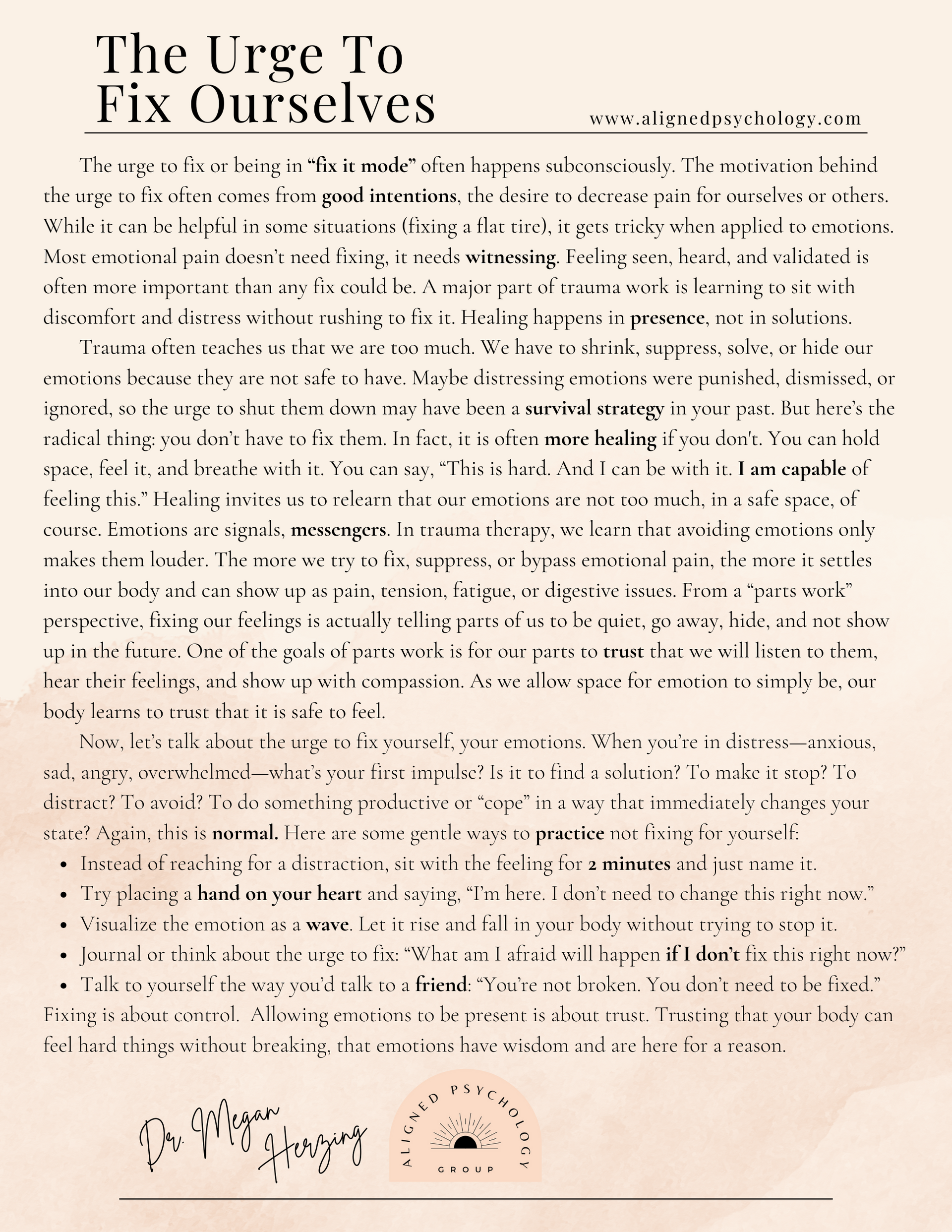Trauma Therapy Homework - Week 20
Week 19: (The Basics) Relationship Mini-Series
The Urge To Fix
Welcome to Week 19 of your trauma therapy homework series. This week, we’re getting into something that shows up in just about every human relationship—including the one you have with yourself. It’s subtle, automatic, often well-intentioned, and frequently exhausting: the urge to fix.
This might be one of those topics where the second you read the title, your nervous system already knows exactly what we’re talking about. Maybe you’ve been on the receiving end of someone trying to fix your feelings when all you needed was to be heard. Maybe you’re the one who rushes in with solutions when someone you love is in pain. Or maybe, like most of us, you do both. Let’s talk about it—honestly, gently, and with a whole lot of self-compassion. Just know that if you struggle with doing this and also experience it in relationships with others, you are normal.

What Is the “Urge to Fix”?
The “urge to fix” or being in "fix it mode" often happens subconsciously. The motivation behind it is the desire to decrease pain for ourselves or others. It often comes from love, caring, and good intentions. And while it can sometimes be helpful in practical situations and when asked for (like fixing a flat tire or solving a tech issue), it gets tricky when we apply it to emotional pain. Because most emotional pain doesn’t need fixing—it needs witnessing. Feeling seen, heard, and validated is more important when feeling distressing emotions than any advice, feedback, or fixing could ever be. That distinction is HUGE in trauma work. In fact, a major part of trauma healing is learning to sit with discomfort without rushing to fix it. Not because we’re helpless, but because healing happens in presence, not in solutions.
When we’re in “fix-it” mode, we often bypass the present-moment experience of simply being with distress. Fixing puts us in the role of a problem-solver instead of a witness. But people (including ourselves) and emotions don’t always need solving—they need space to be exactly where they are. The desire to fix can be a way to regulate our own discomfort more than theirs. Learn and practice pausing, breathing, and staying present with the emotion instead of launching into action. This is an experience of deep healing for ourselves and others.
Fix It Thoughts
If fix it thoughts are more conscious, they may include something like this:
- “I need to make this better.”
- “What can I do to solve this?”
- “How do I stop them (or me) from feeling this way?”
- "How do I fix this problem?"
- “I must be doing something wrong if they’re still upset.”
- “If I give them the right advice, they’ll feel better.”
- “I should know what to do and say.”
- “I need to make this feeling go away.”
- “I should be over this by now.”
- “They need me to have answers.”
- “If I don’t help them solve it, I’m not being supportive.”
These thoughts are incredibly common, and they often come from a nervous system that’s trying to manage discomfort—either someone else’s or our own. But as we’ll continue to explore in this post, the real gift isn’t fixing—it’s being present.

The Impact of Fixing on Trauma Recovery
In trauma therapy, we learn that avoiding emotions only makes them louder. The more we try to fix, suppress, or bypass emotional pain, the more it settles into our bodies. It can show up as anxiety, muscle tension, fatigue, digestive issues, or chronic illness. What we resist, persists. From a "parts work" perspective, or Internal Family Systems (IFS), "fixing" our feelings is actually telling parts to be quiet, to go away, to hide themselves, and to not show up in the future. One of the goals of parts work is for our parts to trust that we will listen to them, hear their feelings, and show up with compassion. When we allow space for the feeling to simply be, without rushing to change it, something powerful happens. The body starts to trust that it’s safe to feel. And that trust is foundational to healing. Holding space for emotions doesn’t mean wallowing or spiraling. It means creating a compassionate container where your internal experience can exist without shame or pressure. It means telling yourself (or someone else), “I’m here. This matters. You’re not alone. I am listening. Your feelings are valid. I can handle this. I can take care of myself while you or I feel this.”
Trauma often teaches us that we’re too much. That our emotions are a burden. That we have to shrink, suppress, or solve everything quickly so we don’t get hurt—or hurt someone else. But healing invites us to re-learn that our emotions are not too much (in safe spaces and with ourselves). They are
signals, not threats. They are
messengers, not enemies. They are
human, not shameful. When you stop trying to fix, you make room to feel. And when you feel, you process. And when you process, you heal.

Our Culture Teaches Us to Fix
Let’s be real: we live in a culture that’s deeply uncomfortable with pain and distress. We’re taught to be productive, to “look on the bright side,” to move on quickly, to "let it go", to manage our emotions like they’re items on a to-do list. This message is everywhere:
- “Don’t cry; it’ll be okay.”
- “You just need to be positive.”
- “Have you tried [insert advice]?”
It’s all meant to help, but the underlying message received is: "This is too much. I can't tolerate your feeling. You’re too much. We need to make this go away." The problem? When someone’s emotional experience is met with immediate fixing, it can feel like rejection. Like their feelings are inconvenient or unacceptable. This can activate feelings of being unheard, unseen, misunderstood, and even shame. For those who’ve experienced trauma, the message they likely receive is: My pain is not welcome. I have to manage it alone.
Noticing the Urge to Fix for Others
Let’s start with one of the most common places this shows up: when someone you care about is struggling. You love them. You hate seeing them in pain. You want to help. That’s beautiful. But before you offer advice or try to solve their situation, check in with your urge to fix.
Ask yourself:
- Am I feeling anxious or dysregulated because they’re upset?
- Am I trying to calm myself down by calming them down?
- Am I assuming they need a solution, or am I giving them the chance to just be heard?
Often, the urge to fix comes from a place of discomfort. Their pain is triggering your nervous system, so you try to shut it down—consciously or not. That’s not wrong. It’s human. But it’s not always what they need.

A More Helpful Approach: Consent
Try this:
“Hey, I’m here, and I want to support you. Do you want feedback, listening and validating, or relating right now? What would feel most supportive?" That consent can change everything. It gives the other person a sense of agency. It tells them: Your emotions are safe here. You get to choose how you’re supported. If they ask for feedback or relating, I still recommend starting with validation and listening. Once they feel you have heard and understood, you can go into what they asked for. Let's break this down.
- Feedback is another word for advice. If they do ask for feedback, I recommend going into a collaborative, brainstorming type feedback. This is where you both will come up with ideas, and you can check in on what they are feeling and thinking toward the ideas. Try saying just one idea at a time and checking in their reaction and response. Then have them say one idea. This is better than telling them what to do or what your ideas are. They know themselves better than you do, and often they already have a great idea and just need help fleshing it out. Work on checking your assumption that you have a "better idea" or the "best idea" for them. This comes from our ego. Work on changing that narrative to "their ideas might be the best fit for them because we are different. They know themselves."
- Relating means sharing our own experiences. After you have listened and validated, you can go into a time where you felt or experienced something similar. This often helps people feel less alone in their experience. The catch here is not to go into making it about you and shift the conversation your way. Share a little of how you can relate and then go back to checking in on them.
- Listening and Validating is more of a reflective process. Imagine you are a mirror and you are trying to reflect back to them what they say they are experiencing, thinking, and feeling. This helps people make sense of their experience in an organized way. Sometimes, clients say, "It just helped to hear it back". Reflect what you are hearing them say and feel without adding any ideas, feedback, or your own experiences.
Please, for the love of the earth, ask before giving advice. No one likes or needs unsolicited advice. I am sure you know how it feels to receive unsolicited advice from others. Most of us have struggled with giving and receiving it. This is so relatable! Let's work on changing it, first in ourselves, then in our circles, and hopefully, in our culture. Real change happens when people hear their own voice. When they find clarity inside themselves—not from someone else’s well-meaning “fix.” The most empowering thing you can do is help them find their own answer, if they are even looking for feedback in the first place.
Instead of giving advice, try asking more questions:
- “What do you think you need right now?”
- “What’s your gut telling you?”
- “What would feel supportive?”
Noticing the Urge to Fix for Yourself
Now let’s talk about the other half of the equation: fixing yourself. When you’re in distress—anxious, sad, angry, overwhelmed—what’s your first impulse? Is it to find a solution? To make it stop? To do something productive or “cope” in a way that immediately changes your state? Again, this is normal. Especially for trauma survivors, intense emotion can feel dangerous. So the urge to shut it down or get rid of it is actually a survival strategy. You’ve likely learned that emotional distress wasn’t safe. Maybe it was punished, dismissed, or ignored. So of course you want to fix it. But here’s the radical thing: you don’t have to fix it. In fact, it is often more healing if you don't. You can hold space for it. You can feel it. You can breathe with it. You can say, “This is hard. And I can be with it. I am capable of feeling this.”
Here are some gentle ways to practice not fixing:
- Instead of reaching for a distraction, sit with the feeling for 2 minutes and just name it.
- Try placing a hand on your heart and saying, “I’m here. I don’t need to change this right now.”
- Visualize the emotion as a wave. Let it rise and fall in your body without trying to stop it.
- Journal or think about the urge to fix: “What am I afraid will happen if I don’t fix this right now?”
- Talk to yourself the way you’d talk to a friend: “You’re not broken. You don’t need to be fixed.”
Fixing is about control. Holding space is about trust. Trusting that your body can feel hard things without breaking. Trusting that emotions have wisdom and are here for a reason.

This Week’s Practice
Here’s how you can explore the urge to fix in real life:
1. Reflect:
- When was the last time I tried to fix someone else’s feelings?
- What was I feeling in that moment?
- What might have happened if I just listened instead?
2. Practice consent:
- Ask someone close to you: “When you’re upset, do you usually want advice or just someone to listen?”
- Use the “feedback, validating, or relating” question in a real conversation this week. "Would you like feedback, listening and validating, or relating? What would feel most supportive?"
3. Notice your self-fix patterns:
- What do I do when I’m upset? (Scroll? Work? Clean? Analyze?)
- Can I pause and sit with the feeling for just one minute before trying to change it?
4. Try a mantra:
- “I don’t need to fix this. I just need to be here.”
- “This is allowed. I can hold space for this.”
- "I am capable. I can tolerate this."
- "I can take care of myself while I feel this."
5. Share what you learn:
- Talk to your therapist or support circle about what you’re noticing. Let others know how they can support you differently.
Final Thoughts
The urge to fix is not bad. It’s a tender, caring, compassionate part of you trying to help. It just needs a little guidance. What most of us really need—whether we’re in pain or with someone else who is—is presence. Kindness. Permission to not be okay. The more we allow space for emotions without trying to change them, the more they move through us instead of getting stuck. So this week, let yourself be a space holder. For others. For yourself. You don’t need to know what to say. You don’t need a perfect answer. Just bring your presence. Your breath. Your kind awareness, listening, and validation. That’s enough. You’re doing brave work. You’re learning a new way. And that, my friend, is something worth holding space for. Until next time—be gentle with yourself. And remember: you are not here to be fixed. You're not broken. You’re here to be felt. And that’s more than enough.
FREE Downloadable Handouts
Click this LINK for free access to downloadable PDFs from the Trauma Therapy Homework Series. You’ll be directed to my Google Drive folder, where you can explore all the handouts created so far. You can choose between a digital format for easy viewing on your device or a printable version if you prefer a hard copy.
Here is a preview of this week's handout! Click the link above to get your own free pdf copy.



ABOUT THE AUTHOR
Dr. Megan
Megan Herzing PsyD, Licensed Professional Clinical Counselor, specializes in trauma therapy and creating a safe, supportive space for healing. She integrates evidence-based modalities, including EMDR, Internal Family Systems (IFS), somatic therapy, and Emotionally Focused Therapy (EFT), to address the mind-body connection and empower clients on their journey to wellness. With extensive experience treating complex PTSD, anxiety, attachment injuries, and dissociation, she believes in the power of self-compassion and authentic connection to facilitate lasting change. Drawing from her own healing journey, she brings empathy and lived experience to her work, honoring each client’s unique path toward growth and resilience.
Thank you for being part of a community of humans that deeply cares about healing.
We are honored that you stopped by and hope our resources will continue to bring value to your life.
We are accepting new clients in California, and referrals are always appreciated.












